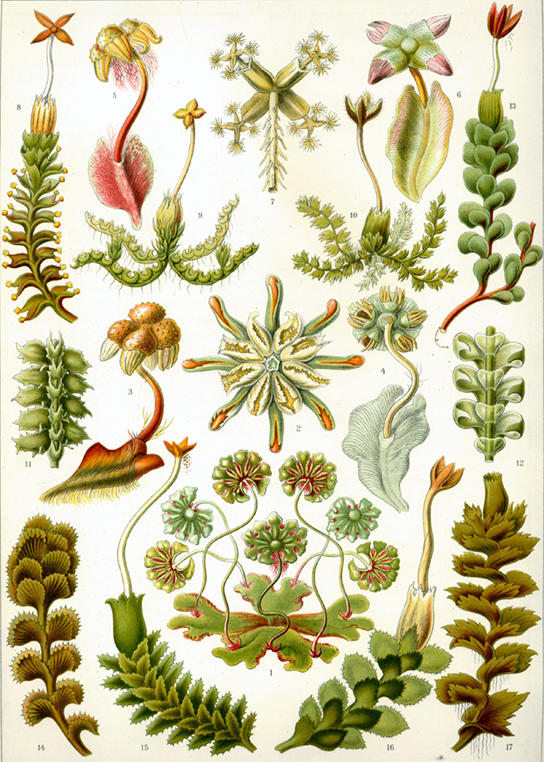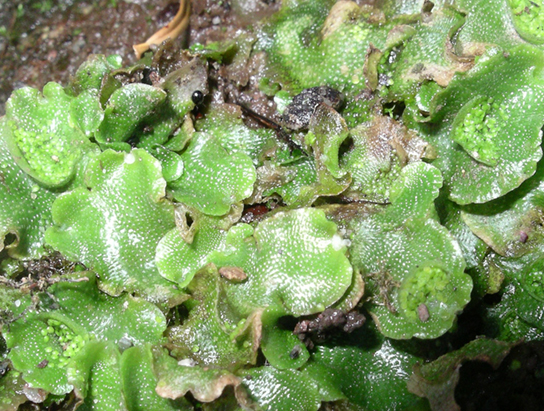| << Chapter < Page | Chapter >> Page > |
Bryophytes are the group of plants that are the closest extant relative of early terrestrial plants. The first bryophytes (liverworts) most likely appeared in the Ordovician period, about 450 million years ago. Because of the lack of lignin and other resistant structures, the likelihood of bryophytes forming fossils is rather small. Some spores protected by sporopollenin have survived and are attributed to early bryophytes. By the Silurian period, however, vascular plants had spread through the continents. This compelling fact is used as evidence that non-vascular plants must have preceded the Silurian period.
More than 25,000 species of bryophytes thrive in mostly damp habitats, although some live in deserts. They constitute the major flora of inhospitable environments like the tundra, where their small size and tolerance to desiccation offer distinct advantages. They generally lack lignin and do not have actual tracheids (xylem cells specialized for water conduction). Rather, water and nutrients circulate inside specialized conducting cells. Although the term non-tracheophyte is more accurate, bryophytes are commonly called nonvascular plants.
In a bryophyte, all the conspicuous vegetative organs—including the photosynthetic leaf-like structures, the thallus, stem, and the rhizoid that anchors the plant to its substrate—belong to the haploid organism or gametophyte. The sporophyte is barely noticeable. The gametes formed by bryophytes swim with a flagellum, as do gametes in a few of the tracheophytes. The sporangium—the multicellular sexual reproductive structure—is present in bryophytes and absent in the majority of algae. The bryophyte embryo also remains attached to the parent plant, which protects and nourishes it. This is a characteristic of land plants.
The bryophytes are divided into three phyla: the liverworts or Hepaticophyta, the hornworts or Anthocerotophyta, and the mosses or true Bryophyta.
Liverworts (Hepaticophyta) are viewed as the plants most closely related to the ancestor that moved to land. Liverworts have colonized every terrestrial habitat on Earth and diversified to more than 7000 existing species ( [link] ). Some gametophytes form lobate green structures, as seen in [link] . The shape is similar to the lobes of the liver, and hence provides the origin of the name given to the phylum.


Openings that allow the movement of gases may be observed in liverworts. However, these are not stomata, because they do not actively open and close. The plant takes up water over its entire surface and has no cuticle to prevent desiccation. [link] represents the lifecycle of a liverwort. The cycle starts with the release of haploid spores from the sporangium that developed on the sporophyte. Spores disseminated by wind or water germinate into flattened thalli attached to the substrate by thin, single-celled filaments. Male and female gametangia develop on separate, individual plants. Once released, male gametes swim with the aid of their flagella to the female gametangium (the archegonium), and fertilization ensues. The zygote grows into a small sporophyte still attached to the parent gametophyte. It will give rise, by meiosis, to the next generation of spores. Liverwort plants can also reproduce asexually, by the breaking of branches or the spreading of leaf fragments called gemmae. In this latter type of reproduction, the gemmae —small, intact, complete pieces of plant that are produced in a cup on the surface of the thallus (shown in [link] )—are splashed out of the cup by raindrops. The gemmae then land nearby and develop into gametophytes.

Notification Switch
Would you like to follow the 'Biology' conversation and receive update notifications?